Andrew and I enjoyed our first afternoon in Rogers City, Michigan at the Great Lakes Lore Maritime Museum. It didn’t take long, before we became hooked on all things ‘freighters’ and ‘shipwrecks’. That same afternoon, I saw several ads for the Great Lakes Shipwreck Museum at Whitefish Bay, in the Upper Peninsula. I hadn’t planned on making our trip a homeschool vacation, but then again, homeschool never stays home! From past experience, I knew that if I put off this side trip until the ‘end’ of the week, that there was a possibility that it might not happen. Determined to make a go of it, we buckled up and headed out the following morning.
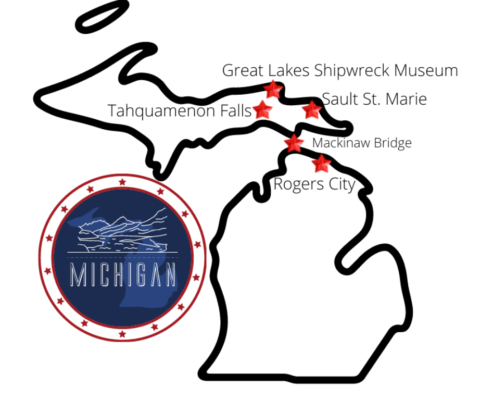
A Side Trip from the Side Trip – Sault St. Marie and the Locks
I always pack in as much adventure as possible, so we didn’t head straight to the Great Lakes Shipwreck Museum like one would suspect. Instead, I headed straight north to the Sault Saint Marie Locks. I decided it was just as important to learn about freighters and the navigation that happened “on top” of the Great Lakes.

Mackinaw Bridge
To get to Sault Saint Marie, we had to cross the Mackinac Bridge. (Pronunciation: mack-i-naw) The Mackinac Bridge, known as the Big Mac or the Mighty Mac, is 5 miles long, and offers a beautiful view of Lake Michigan on the southbound side, and Lake Huron on the eastbound side. As of July 2021, the toll for our van was $5.00. Andrew, thoroughly enjoyed the scenery and snapped a ton of photos on our way over the straits. Me? I’m just not keen on bridges. I kept a death grip on the steering wheel and my eyes glued to the back of the pick up in front of me. Thankfully the weather was nice and the wind was calm.
Sault St. Marie, Michigan
If you go to Sault St. Marie, take the last US exit on I 75. However, if you miss this turn off, you will find yourself at the International Bridge, just before the Canadian border. It is a good reason to not get lost in the beauty and excitement of the area.
Sault St. Marie is the oldest city in Michigan, (1668) and the second largest in the Upper Peninsula. Navigating the city streets is easy; its the tourists that make driving difficult! By the way, Sault is pronounced ‘soo’ which is also the Anglican nickname for the area. Michiganders will refer to Sault St. Marie as “The Soo” or the locks, as the “Soo Locks”.
I knew that it could take hours to see a freighter enter the Soo locks so I was a bit stressed about fitting my travel itinerary into the day. However, the travel angels were on our side! I found a parking spot that even I could pull into – right in front of the locks! If that wasn’t luck enough, exiting the car, Andrew jumped just as we heard the loud, deep fog horn of a freighter! Our activities were aligning nicely. I took a deep travel breath.
The Captain Henry Jackman
The Captain Henry Jackman, a Canadian freighter, was sailing from west to east and was already entering the locks when we arrived. It was so long we couldn’t get the entire freighter in one photo! I am not the best at splicing photos but it gives an idea of the incredible length. The Jackman carried 39,000 tons of product and headed to Quebec Canada.

*Note: Since our encounter with the Captain Henry Jackman, Andrew and I have tracked it and watched its coming and goings at vesselfinder.com.
Andrew and I were both curious about what it takes to work on a freighter. A volunteer at the locks museum told us that sailors work 6-7 months of the year and average 50-65,000 dollars a season. Officers start at around 90,000 and Captains make about $180,000. Andrew asked about advancement and discovered that the best way is to go to a maritime academy, or one can ‘scruff’ their way up through the ranks. Andrew looked more interested in ‘scruffing’ than the schooling portion.
A Snippet of the Locks History
The St. Mary’s River is the only connection between Lake Superior and the rest of Michigan’s Great Lakes. Historically, the area was difficult to navigate and fur trappers had to unload and hike their canoes and pelts around the rapids and waterfalls. The term ‘sault’ is French for rapids. Lake Superior sits 21 feet higher than the rest of the Great Lakes. To make this area more navigable, the Northwest Fur Company constructed a lock in 1797. This lock made it possible to navigate from Duluth, MN to the Atlantic Ocean but Americans were not the only ones interested in shipping. The British were too, and soon Michigan was at the center of the American-British turmoil during the War of 1812. The Americans destroyed the lock instead of letting it fall into Britain’s hands, and 43 years passed before it was reconstructed.
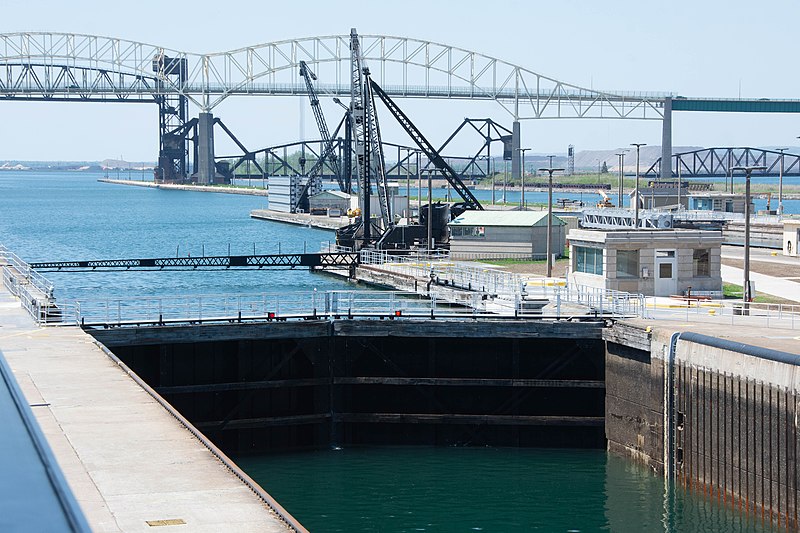
How the Locks Work
To traverse the locks, a gate opens allowing the ship to enter. When settled, the gate closes and valves allow the water to flow in or out, dependent upon which direction the ship is sailing. The locks do no require water pumps because the entire process occurs because of gravity. Because Lake Superior is higher than the rest of the Great Lakes, freighters traveling towards Lake Superior enter the locks and water valves flow into the lock raising it to the same level as Lake Superior.
A 21 foot difference doesn’t sound like much, but it takes 22 million gallons of water to raise or lower the lock level. When the ship reaches the water height of the next Great Lake, the opposite gate opens and the ship sails out. It takes 9 hours for a boat to traverse the Saint Mary’s River between Lake Superior and Lake Huron! It is difficult to tell just how long the locks are. We found out that the MV Paul R. Tregurtha is longest freighter on the Great Lakes. It is 1,113 feet – more than 3 football fields long. That means the locks have to be that long too!
The Great Lakes Shipwreck Museum
We had a nice meal at the Lockview Restaurant, and then we were back on the road and headed over to Whitefish Bay, to go to the Great Lakes Shipwreck Museum. It was about an hour and half drive. If Whitefish Bay sounds familiar, it is probably because you heard it in the Gordon Lightfoot’s song called, The Wreck of the Edmund Fitzgerald. The song tells about the November storm, in 1976, when the freighter, Edmund Fitzgerald sank off the coast of Whitefish point. The bell and other artifacts can be seen at the museum.
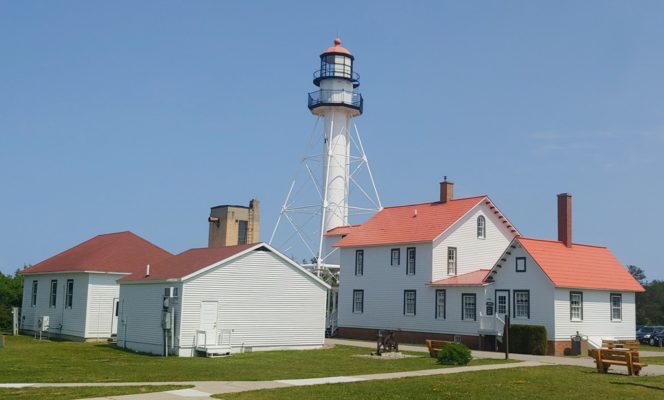
When entering the museum there is a cool exhibit of skin divers hovering over a shipwreck. It is so lifelike that in Andrew’s words, “It was just like being under water.” The museum houses items retrieved from various shipwrecks and tells each story. We spent the rest of the afternoon reading about different shipwrecks.
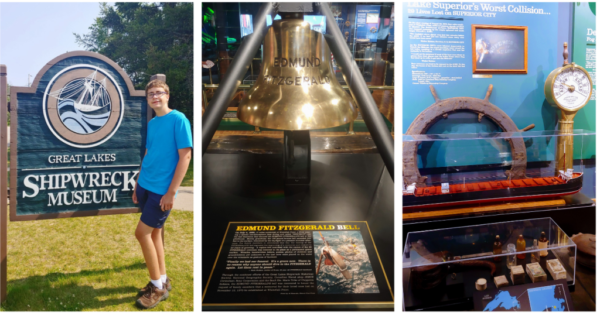
Underwater Research
There are still undiscovered shipwrecks in the Great Lakes, and we learned that the underwater research is being hampered by the Zebra Mussel. This mussel invaded the Great Lakes by way of contaminated cargo water from an international ship in the late 1980s. When I was a kid, it was rare to find a shell on any of the Great Lake’s beaches. Since then, they are now littered with these black and white shells. Not only are the beaches affected, but like barnacles, they cover anything submerged in the water. The Zebra Mussel multiples and covers all aspects of any submerged shipwreck, thus making underwater archaeology and research difficult. It is a race of time to explore the the Great Lakes before historic shipwrecks are lost to these underwater parasites.
Andrew and I spent about three hours in the museum, before we migrated past the lighthouse to the Lake Superior overlook. There we found a beautiful Lake Superior beach with lots of rock hounds, swimmers, and sun-worshiping marinators. We joined the rock hounds, and took a look around before calling it a day. If we hadn’t been hot and suit-less we would have stayed longer.

One More Side Trip from the Side Trip
Tahquamenon Falls
Andrew was ready to head back to Rogers City, but my inner travel clock said it was still daylight and we had time to fit in one more side trip. It didn’t take long for Andrew to fall asleep, and when he woke, we were at Tahquamenon Falls. We did the quick hike and enjoyed the scenic view of the falls. The sun was getting low and I knew that if I were going to cross the Mac bridge with less anxiety than I had in the morning, we needed to leave.
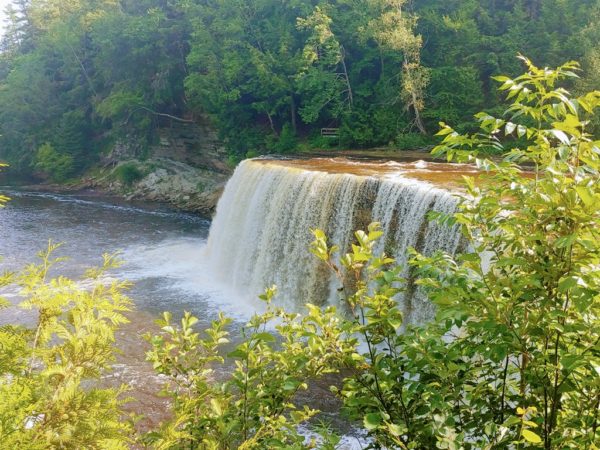
We took a bit of a breather in St. Ignace, and watched the sunset, as well as a few freighters cross under the Mackinaw bridge before we headed back over the straits of Mackinaw. This was a very easy drive from Rogers City, and a great homeschool adventure, as well. Our questions and desire to know more about Great Lakes Shipping started with the maritime museum in Rogers City, and then strengthened by the Great Lakes Shipwreck Museum.
Thunder Bay Sanctuary
South of Rogers City, on US 23, is the city of Alpena, which is located on Thunder Bay, also known as Shipwreck Ally. The Great Lakes Heritage Maritime Center was next on our to-do list. However, as of July 2021, it remained closed due to the Pandemic. These are crazy times, so it is always a good idea to call first.
Moving down our to-do list, our next option was The Thunder Bay National Marine and Underwater Preserve. The Thunder Bay Sanctuary is home to 200+ shipwrecks, half of which are positively identified. There are two ways to see the shipwrecks: from above or below water. Skin divers have the advantage to see the wrecks up close, however, for the average tourist a sightseeing cruise and a glass bottomed boat is the driest option.
I booked our shipwreck cruise for Friday, the last day before we were to drive home. The weather, was beautifully calm all week, until several lines of storms moved through Thursday night. Our morning cruise was cancelled due to lingering storms and the afternoon cruises were full.
Guess we will have to return next summer to finish our unit on the Shipwrecks of the Great Lakes! Andrew and I have added skin diving as a new bucket list adventure. Who knows, maybe next year we will see the wrecks up close and personal!
Check out our other experiences in NE Michigan!
We Found the Caribbean of the North, Rogers City, Michigan
Discovering a Drawbridge and the Lighthouses of Northeast, Michigan


